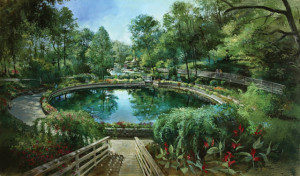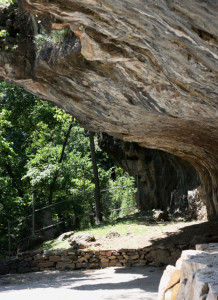A sacred and historical area where spirits of ancient Indian tribes can be felt, where remnants of white settlers lives can be seen, and where vivid pictures of past cultures can be imagined.

For thousands of years, water flowing from Blue Spring—located a few miles west of Eureka Springs on a peninsula steeped in ancient history and surrounded by the White River—has remained a constant source of energy and power: it is a magnet that feeds the spirit, heals physical and emotional wounds, and helps build communities. History shows that American Indian tribes put their differences aside when they entered the sacred grounds of Blue Spring.

Situated on 33 acres around the spring is Blue Spring Heritage Center, featuring an ancient bluff shelter, a pavilion overlooking a trout-stocked lagoon, winding paths around native gardens, an historic mill site, and handicapped-accessible walkways that weave through lush woodlands. There is a charming visitor center with numerous sites for special events.

The bluff shelter, listed on the National Register of Historic Places, served not only as a refuge for ancient tribes but was also used as a place for rituals. American Indian elders relate stories of visits to Blue Spring and the important ceremonies held in the bluff shelter. In July, 2003, an American Indian blessing of the spring reestablished the sacredness of the land.
Prehistoric artifacts found on the property, including a “rice contracting stem” (a thin narrow arrow head), date the area as being inhabited more than 10,000 years ago. In 1971, Robert G. Chenhall and a team of his students from the University of Arkansas uncovered fossils, including those of shellfish, deer, and turtle. They also uncovered Indian graves, fire pits, small arrow points, and Woodward Plain’s pottery.
The area around Blue Spring was an Osage Indian trading post where the Osage made and traded boats with white trappers and hunters. The boats they crafted were used on the White River to transport beeswax, bear oil, and furs to New Orleans. This tribe was referred to by local settlers as the “Strongboat Indians.”

The spring was used by white settlers starting in the late 1800s. The Cross family, whose involvement in Blue Spring spans over a century, purchased the area in 2002 and changed its name from Eureka Springs Gardens to Blue Spring Heritage Center. The family tested the water and found it to be the purest in the region. In an endeavor to bring the historical area back to its roots and to highlight the land’s heritage as well as the beauty of the natural world that is nourished by the spring, the family reintroduced indigenous plants and sacred herbs, and offers activities to educate and entertain Blue Spring visitors: It has become a place where the culture and customs of both Native American Indians and the early settlers is emphasized.
The Cross family continues to honor its commitment to the spring, its land, and making Blue Spring an open and available attraction for all to experience and enjoy. It is open 9 a.m.-6 p.m. March 15 through Thanksgiving. Visit bluespringheritage.com.
Blue Spring 411
• Constant 54ºF
• Pumps 38 million gallons every 24 hr.
• 70 ft. in diameter at the surface
• Actual spring opening: 10 ft. diameter, 25 ft. below the surface
• Sound-tested to a depth of 510 ft.
• Divers have researched the spring down to 210 feet where a 12-in. restriction prevented them from delving further into the depths of this mysterious water source.
Blue Spring History
1839—Cherokee Indians, on their enforced “Trail of Tears” walk from Echoto, Georgia, to Oklahoma, stopped at Blue Spring for nine days before crossing the river and continuing onward. In American Indian oral tradition, they had long known about the spring and knew it would be a pleasant respite.
1840—A corn-grinding gristmill was erected downstream from Blue Spring, but burned during the Civil War.
1903—A new saw, corn, and flour mill was built in 1903, ceasing operation in 1943. Its turbine can be seen at Blue Spring.
1872—“The Timber Queen,” German immigrant Franciska Massman, a colorful businesswoman who was famous for her rapid fire clear-cutting and homesteading tactics, moved into the current site of Eureka Springs and eventually purchased more than 32 land patents and timber rights for 5,000 acres of pine in the surrounding area.
Late 1800s—White settlers who moved into the area found Blue Spring and erected makeshift living quarters in the bluff shelter there. (Photos, historical documents, and artifacts can be viewed in the Visitor Center.)
1902—A gentleman named Baird bought the land at Blue Spring, constructed a concrete and rock wall around it, piped the opening, and ran water lines across the bottom of the White River. The spring water was then loaded into glass-lined railroad cars and shipped to the Southwest for consumption. Baird’s business folded after one year, and in 1908 the Eureka Blue Spring Water Company attempted to bottle and sell the water. This business also ceased and after two years of operation the spring sprung forth again. Free!
1946—Blue Spring became a tourist attraction.
1993—The spring was renamed Eureka Springs Gardens and transformed into 33 acres of colorful landscape that included hardwood trees, native plants, and ever-changing flora. It attracted thousands of visitors.
M! FM 2013

Leave a Reply